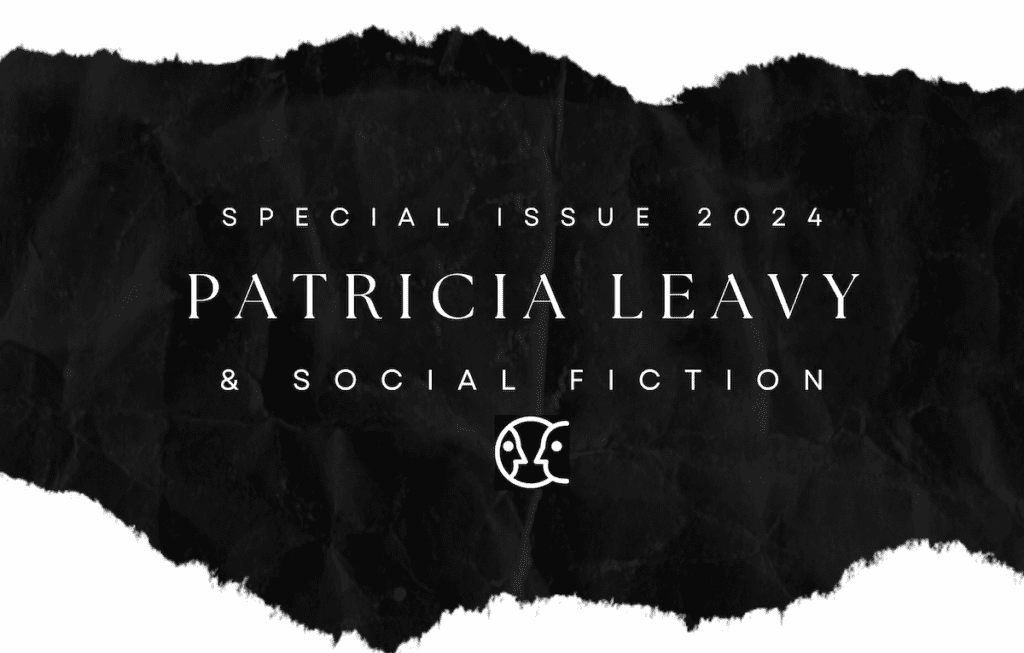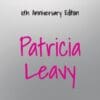Celebrating Dr. Patricia Leavy’s Body of Work: An Introduction to This Special Issue
Laurel Richardson and U. Melissa Anyiwo
The invitation to write the introduction to this special issue celebrating Dr. Patricia Leavy’s work is both a great honor and a daunting task. Where to begin? What to cover in such a diverse, expansive, and rich career? How to make sense of and pay homage to an enormous portfolio and how to affirm the significant, critical, and enduring role of Patricia’s work within and beyond the academy? How to acknowledge the human side of one of our most prolific scholars? A daunting task indeed. Look at the numbers.
Patricia Leavy’s Career by the Numbers
Patricia Leavy has published over 40 books, works of fiction and nonfiction, and more than 500 journal articles, essays, op-eds, blogs, and interviews. She has also served as creator and editor for 10 book series, cofounded a journal, and founded her own publishing imprint. Add to this numerous editorial boards, advisory boards, and radio, podcast, vlog, and television appearances. By the numbers, it’s a massive body of work. But Patricia Leavy’s work is not about numbers. It’s about words.
To try to do justice to a body of work whose impact will be seen for decades to come, we’ve organized our thoughts into a series of concepts or themes. These are all different angles by which we might view Patricia’s work, and taken together, we hope they capture the highlights of an extraordinary career with the promise of much more to come.
Firsts: Innovation and Trailblazing
Innovation is at the heart of Patricia’s work. Most scholars write articles and books on topics for which there are already innumerable articles and books. Most use the language created by others. Few scholars will ever be the first to do anything. In rare instances, a scholar does write the first book on a topic or coins a new term that is taken up by the research community. These are exceptions, and those who do so, are lucky to do so once. We can view Patricia’s entire career as a series of firsts.
Patricia had been publishing innovative articles since the late 90s, textbooks on qualitative and emergent research practices since the early 2000s, and a 2007 monograph that delineated a new way to understand collective memory in the media age.
Innovation is at the heart of Patricia’s work.
Notwithstanding these important works, it was the 2008 publication of her groundbreaking book Method Meets Art: Arts-Based Research Practice that served as a clear turning point, and the first of many firsts. Method Meets Art was the first research methods book about arts-based research. The book covered all the major artistic genres: literary, performative, and visual. In this text, Patricia introduced arts-based research as a set of methodological practices, delineated a new way to do research, mapped the historical and contemporary landscape, and created evaluation criteria. In doing so, she opened up an entire field. Method Meets Art has influenced research practice in art education, education, communication, sociology, psychology, gender studies, and many other fields.

At the time of its original publication, few professors taught arts-based research. As a result of Method Meets Art, arts-based research is now regularly taught in education and social science departments around the world and has been the subject of countless journal special issues, conferences, and other publications. Considered a “bible” by many, this beloved text is now in its third edition, remains widely adopted in classes across the disciplines, has been cited in countless theses, and has been translated into numerous languages. The Chinese translation of Method Meets Art was the first book published in China about arts-based research. Method Meets Art is a landmark publication.
Patricia had been publishing innovative articles since the late 90s, textbooks on qualitative and emergent research practices since the early 2000s, and a 2007 monograph that delineated a new way to understand collective memory in the media age.
Patricia is also the author of the instant bestseller, Research Design: Quantitative, Qualitative, Mixed Methods, Arts-Based, and Community-Based Participatory Research Approaches, now in its second edition. This is the first research methods text to cover the five approaches to research and thus radically changed the way research methods is taught across the disciplines. No single book has influenced the practice and teaching of research design as much since the publication of John Creswell’s design book in the 90s, which presented an alternative to Earl Babbie’s widely used textbook.
She also published the first authored methods books on transdisciplinary research and fiction as a research practice. Recently, she released Re/Invention: Methods of Social Fiction, the first and only book on the practice of social fiction, a term she coined in 2010 and a method she delineated and has pioneered around the word.
Patricia’s fiction is no different. For example, her debut novel, Low-Fat Love, is the first published novel called “social fiction.” Her award-winning book Spark is the first and only novel to explore the interdisciplinary research process itself.
Patricia is also the author of the instant bestseller, Research Design: Quantitative, Qualitative, Mixed Methods, Arts-Based, and Community-Based Participatory Research Approaches, now in its second edition.
Her editing work has also been trailblazing. Among her many notable edited books are the Handbook of Arts-Based Research, a first of its kind, as well as The Oxford Handbook of Methods for Public Scholarship, another first. The ten book series she has created and edited also center on innovation—in subject areas, perspectives, writing styles, and approaches. This is no more clear than with the Social Fictions book series, which Patricia created and for which she served as editor for a decade.
The Social Fictions series is the first and only book series published by an academic press that exclusively publishes literary works, such as novels and plays. The series changed both the academic and publishing landscape. During her time as editor the series received thousands of submissions, published 45 books including several bestsellers, and earned a national creativity award. On a personal note, we have both published multiple books in her series and have been grateful for her unfailing support as an editor.
As you can see, this is a career that we could define by firsts. Big firsts.
Paradigm Shifts
The innovation propelling Patricia’s body of work, has contributed to paradigm shifts. We see this in primarily three areas: the arts as knowing, fiction and storytelling, and public scholarship.
Patricia’s work as a leading scholar in arts-based research, and the field’s most visible proponent, has created a paradigm shift. Researchers are no longer stuck choosing between quantitative, qualitative, or mixed methods research designs, but can now turn to arts-based research. As previously noted, her book Method Meets Art changed the way the arts are recognized and used in research, as have her many books and talks that followed. Journals in diverse disciplines have acknowledged the impact of Method Meets Art in glowing reviews. Scholars have as well. For example, Dr. Mindi Rhoads at The Ohio State University said, “It is a paradigm shift—a real game-changer.”
By creating the method of “social fiction” and promoting that method through her books, articles, and book series, Patricia has created an entirely new genre of writing. Social fiction merges scholarly and literary forms of writing. Her work has created both a paradigm shift in the academy and in publishing. Countless students and researchers now use this method of inquiry due to her groundbreaking efforts. Her work in social fiction has done something else that we think is significant and holds special value for the autoethnography community. Patricia’s work has placed a premium on storytelling and telling stories well.
The innovation propelling Patricia’s body of work, has contributed to paradigm shifts. We see this in primarily three areas: the arts as knowing, fiction and storytelling, and public scholarship.
Finally, while there has been a shift for decades towards public scholarship, something Patricia has chronicled in several of her texts, her work has also contributed significantly toward this new paradigm. By presenting her research as novels and short stories and advocating for arts-based research and storytelling more broadly, Patricia’s work has made public scholarship a real possibility for countless others. She further models public intellectualism by participating in countless radio, podcast, newspaper, and blog interviews in which she tirelessly champions the arts and fiction as ways of knowing.
Border Crossing, Tensions, Messiness, Contradictions, Emergence
We believe the many firsts and paradigm-shifts we’ve noted stem from Patricia’s willingness to cross disciplinary borders, embrace tensions and messiness in research, remain open to contradictions, and experiment so that new ideas may emerge. This is the path of someone who has chosen the road less travelled. By modeling a willingness to experiment, play, and problematize, challenge, and cross long-held divisions, such as fact-fiction, Patricia has encouraged others to do the same.
Creativity and Artistry
In 2014 Patricia received the Special Achievement Award from the American Creativity Association. Other recipients of the same award include astronaut John Glenn and Pixar Studios. This honor illustrates the impact of her work on a national level. She was specifically honored for her work advancing arts-based research and developing the Social Fictions series.
As is clear from her catalog of books, the wide array of topics on which she has written, her numerous collaborations with other writers and artists, and her mastery of both nonfiction and fiction, Patricia is a creative writer and thinker.
In 2014 Patricia received the Special Achievement Award from the American Creativity Association.
As her friends, we know that what Patricia values most in her career is her attention to her craft and the seriousness with which she approaches literary writing. Patricia writes seven days a week, often sitting in corners of cafés, revising scenes over and over again. She revises her novels dozens of times, carefully selecting each word. Understanding that in the end, it comes down to the words on the page, she spares no effort to get her stories just right. As readers of her novels, we see the time and love she puts into every page. Scholars who turn to an art form, in this case fiction, face assumptions that their work isn’t up to par. This could not be further from the truth in Patrica’s case. She is a gifted novelist.
Her characters are beautifully and sensitively rendered, the dialogue rings true, and the stories are impossible to put down with supremely satisfying endings. Patricia’s novels resonate deeply, often causing a well of unexpected emotions in readers. Moreover, she does not follow any formula, not one set by other authors or one she has created. Her novels span genres and structures. Within each genre, including romance her recent genre of choice, she writes in her own unique voice. It is not surprising that her work has received praise even in the highly competitive world of trade magazines. For example, in their glowing review in which they “highly” recommended her novel Hollyland, Midwest Book Review called it “laudably original,” a remark that has been echoed many times across reviewers and novels. Moreover, they also said Hollyland was, “Written with the kind of eloquence associated with award winning literary fiction.”
Social Justice and Humanitarianism
We would be remiss not to add something about Patricia’s dedication to social justice, which permeates all aspects of her work. In fact, social justice is a core value underscoring her work. The innovative approaches to research she champions in her textbooks allow for far greater inclusion in scholarship. She fights for more voices. The examples she uses throughout her texts routinely center on gender, race, ethnicity, class, and sexuality. There are also the “small” things, that aren’t so small, such as using inclusive pronouns or capitalizing racial categories in textbooks, which she began to do before it was a norm, in some cases fighting for the right to do so.
Likewise, in her fiction she has taken up a range of justice issues including, sexism, sexual harassment, rape, childhood abuse, racism, homelessness, environmental concerns, and homophobia as well as often taboo topics including depression, suicide, self-esteem, and eating disorders. Her novels both accurately portray the real-world while also offering role models of characters who quietly make the world a better place. It is not surprising that her novels feature characters from all walks of life, diverse in terms of gender, race, ethnicity, religion, social class, and age.
Likewise, in her fiction she has taken up a range of justice issues including, sexism, sexual harassment, rape, childhood abuse, racism, homelessness, environmental concerns, and homophobia as well as often taboo topics including depression, suicide, self-esteem, and eating disorders.
Her attention to the core value of social justice extends beyond her own writing. Her edited volumes and book series promote social justice issues. Moreover, she has included a diverse array of authors who explicitly write about race, gender, sexuality, disability, and other similar topics. She has routinely privileged underrepresented voices and perspectives. For example, her Social Fictions series includes numerous books featuring non-binary and transgender characters, as well as books that explicitly deal with race and racism.
In 2022 Patricia was honored by We Are the Real Deal with an award for “Her Leadership and Humanitarian Efforts in Literature and Publishing.” This award rightfully recognized her long track record of tackling difficult subjects in her novels and making a more inclusive research landscape through her nonfiction. This award also recognized her efforts in publishing, privileging underrepresented voices. As we have both published in Patricia’s book series, we understand this was also recognition for her behind the scenes efforts to transform academic publishing for the better. For example, she used her considerable clout at one publishing house to fight for better terms for authors, a battle she won.
Concluding Remarks
We can define Patricia in many ways: scholar, sociologist, methodologist, philosopher, public intellectual, novelist, artist, editor, publisher. Those titles, while true, are also limiting, which is why Patricia Leavy has been called a rock star, legend, icon, trailblazer, light, breath of fresh air, visionary, pioneer, shining star, leader, rebel, renegade, inspiration, and modern-day Simone de Beauvoir. As both admirers and friends, we would also call her kind, loyal, open-minded, brave, passionate, compassionate, generous, genuine, curious, grateful, disciplined, hard-working, funny, sarcastic, self-deprecating, and humble. When we ask Patricia to describe herself, she simply says, “I’m a writer.”
About the Authors

Laurel Richardson, Ph.D., is a Distinguished Emeritus Professor of Sociology at The Ohio State University. She has been honored with multiple awards including the Lifetime Achievement Award from the International Congress of Qualitative Research. She is the author of numerous books including the landmark text, Fields of Play, and recent autoethnographic works such as Seven Minutes from Home: An American Daughter’s Story and Lone Twin: A True Story of Loss and Found.

U. Melissa Anyiwo is a Professor of History and Director of Black Studies at the University of Scranton with 20+ years’ experience. The focus of her career has been advancing the representation and inclusion of minoritized communities and individuals to aid expanding knowledge and understanding of justice, equity, diversity, and inclusion (JEDI). Her teaching includes the U.S. History and Culture sequence, where she regularly uses texts by Patricia Leavy to enhance and a range of Black Studies courses based in historiography often using the vampire as an inclusive pedagogy. She has been using works by Patricia Leavy since 2012 including Low-Fat Love (2011), Film (2019), Spark (2019), and Re/Invention: Methods of Social Fiction (2022) to enhance her teaching.
Melissa has published on inclusive practices including “That’s Not What I Signed Up For”: Teaching Millennials about Difference through First-Year Learning Communities” in Outside/In in Teaching Race & Anti-Racism in Contemporary America (2013) and “Using Vampires to Explore Diversity and Alienation in a College Classroom” in The Vampire Goes to College (2013). Finally, she starred in the WVIA Short “It’s More Than Hair” (2023), the Podcast Systemic episode “Policing Black Bodies” (2023) and the documentary “Lestat, Louis, and the Vampire Phenomenon” for the Interview with the Vampire 20th Anniversary Edition DVD (Warner Brothers, 2014).
Credits
All images provided by Patricia Leavy
Learn More
New to autoethnography? Visit What Is Autoethnography? How Can I Learn More? to learn about autoethnographic writing and expressive arts. Interested in contributing? Then, view our editorial board’s What Do Editors Look for When Reviewing Evocative Autoethnographic Work?. Accordingly, check out our Submissions page. View Our Team in order to learn about our editorial board. Please see our Work with Us page to learn about volunteering at The AutoEthnographer. Visit Scholarships to learn about our annual student scholarship competition.














